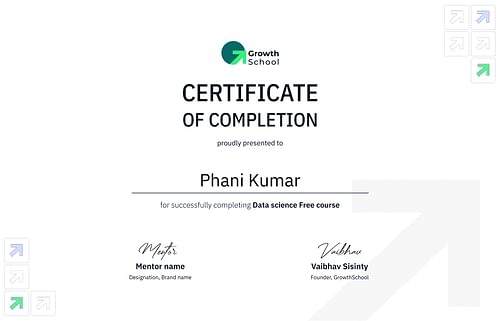Free Product Management Course to Become A Product Manager (Roadmap)
Learn how to become a Product Manager with our step-by-step roadmap. Access free product management courses now!
Before you ask, we do give certificates!
Get certified upon course completion and supercharge your career journey.

Learning Objectives
1. Diverse Skill Set in Product Management
Develop a wide range of technical and soft skills, including data analysis, communication, and problem-solving for effective product management.
2. User-Centric Product Development
Prioritize user needs by incorporating feedback, guiding product development strategies, and building relationships with stakeholders to ensure successful product delivery.
3. Data-Driven Decision-Making
Leverage data analysis skills to justify decisions, interpret market trends, and prioritize features based on customer needs, enhancing product success.
4. Transitioning to Product Management
Adopt a data-driven approach, gain relevant experiences, shadow existing product managers, and tailor cover letters to secure roles in product management effectively.
Read More
Who's it for
Aspiring Product Managers
Current Product Managers
Tech Professionals
Healthcare Industry Professionals
Job Seekers in Product Management
Our Learners love GrowthSchool
What will I learn
Chapter 1
Introduction to Product Management
This chapter sets the stage by emphasizing the pivotal role of product management in product development. It discusses the unique skills and attributes required for successful product management, debunking common misconceptions about the job's complexity and highlighting the importance of driving product vision, strategy, and execution.
Chapter 2
Skills Required for Product Management
Exploring the essential skill sets for product management, this chapter delves into the technical and soft skills necessary for excelling in the field. It discusses the importance of a diverse skill set encompassing data analysis, market research, communication, negotiation, and problem-solving, emphasizing the need for a deep understanding of target audience preferences.
Chapter 3
The Multifaceted Role of Product Managers
Delving into the multifaceted and demanding nature of the product management role, this chapter discusses the importance of continuous learning and adaptability. It emphasizes the role of product managers as bridges between various teams, highlighting their responsibilities in understanding user needs, prioritizing capabilities, and fostering effective collaboration.
Chapter 4
Driving Product Success through Customer-Centric Approaches
This chapter focuses on the critical aspect of aligning products with customer needs to achieve success in the market. It discusses the responsibilities of product managers in product development, strategy, and ensuring that products meet customer requirements by understanding market dynamics, competition, and user needs.
Chapter 5
Leveraging User Feedback in Product Development
Highlighting the significance of user feedback in product development, this chapter emphasizes how product managers can leverage customer insights to guide decision-making processes. It discusses the collaboration skills necessary to build relationships with stakeholders, gather insights effectively, and influence decisions based on user feedback.
Chapter 6
Transitioning into a Product Management Role
This chapter provides practical advice on transitioning into a product management role, focusing on adopting a data-driven approach to decision-making and enhancing one's skill set through relevant experiences. It discusses the importance of shadowing existing product managers, developing tailored cover letters, and reaching out directly to companies for job opportunities.
Chapter 7
Product Management in the Healthcare Industry
Exploring product management in the healthcare sector, this chapter discusses the benefits of understanding healthcare equipment and software systems for aspiring product managers. It highlights the importance of showcasing knowledge of healthcare practice management systems and coding skills, if applicable, to enhance candidacy in healthcare companies.
Chapter 8
Conclusion Driving Product Success Through User-Centric Approaches
Bringing the discussion to a close, this chapter reiterates the dynamic and vital role of product management in creating innovative and successful products. It emphasizes the importance of focusing on understanding user needs, collaborating with diverse teams, and continuously learning and adapting to drive product success effectively in the ever-evolving market landscape.
Meet your Mentor
Mukul Lele
Senior Product Manager @ Microsoft
Mukul Lele is a Senior Product Manager with extensive experience at companies like Microsoft and Adobe. At Adobe, he leads the Employee Skilling initiative, focusing on enterprise education and product integrations. He also drives accessibility efforts and mobile app development, achieving a high app store rating through user-centric design and strategic prioritization.
Frequently Asked Questions
What are the main pillars of Product Management?
The main pillars of Product Management are strategy, execution, communication, and cross-functional collaboration.
What is Product Management, and why is it important to learn about?
Product Management involves understanding customer needs, market trends, and overseeing product development to drive business success.
Is this Product Management course designed for corporate training and workforce upskilling?
Yes, the course is designed to enhance skills and knowledge for professionals seeking to excel in product management.
How long can I access the free product management course content?
You can access the free course content for an unlimited period once you enroll in the course.
Will I receive a certification upon completion of the free product management course?
Yes, you will receive a certification upon successful completion of the free product management course.

Coming Soon
Advanced
Mentor
Mukul Lele
Senior Product Manager @ Microsoft
Why GrowthSchool?
GrowthSchool is where you become the Top 1% in your field. We bring the best of Product, Growth, Design, Tech, data and business mentors from brands like Google, Meta, Uber etc doing the jobs you want to do tomorrow.
400k+
Total Students
Top Startup India 2024
Backed by the best
and 80+ Angel investors like



What are Free Courses?
Free online courses offer a wealth of knowledge in product, design, growth, and marketing without cost. They provide flexibility for skill enhancement and professional development. Many courses include certificates, bolstering resumes and LinkedIn profiles, demonstrating a commitment to learning and advancement in these dynamic fields.




